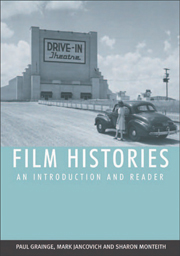Book contents
- Frontmatter
- Contents
- Preface
- Part I Film History from its Origins to 1945
- Part II Film History from 1946 to the Present
- 13 Postwar Challenges: National Regeneration, HUAC Investigations, Divestiture and Declining Audiences
- 14 The Politics of Polarisation: Affluence, Anxiety and the Cold War
- 15 Cinematic Spectacles and the Rise of the Independents
- 16 New Waves, Specialist Audiences and Adult Films
- 17 Radicalism, Revolution and Counter-Cinema
- 18 Modernism, Nostalgia and the Hollywood Renaissance
- 19 From Movie Brats to Movie Blockbusters
- 20 The Exhibitors Strike Back: Multiplexes, Video and the Rise of Home Cinema
- 21 Postmodernism, High Concept and Eighties Excess
- 22 Cults, Independents and ‘Guerrilla’ Filmmaking
- 23 From Cinemas to Theme Parks: Conglomeration, Synergy and Multimedia
- 24 Globalisation and the New Millennium
- Bibliography
- Copyright Acknowledgements
- Index
22 - Cults, Independents and ‘Guerrilla’ Filmmaking
from Part II - Film History from 1946 to the Present
Published online by Cambridge University Press: 05 August 2013
- Frontmatter
- Contents
- Preface
- Part I Film History from its Origins to 1945
- Part II Film History from 1946 to the Present
- 13 Postwar Challenges: National Regeneration, HUAC Investigations, Divestiture and Declining Audiences
- 14 The Politics of Polarisation: Affluence, Anxiety and the Cold War
- 15 Cinematic Spectacles and the Rise of the Independents
- 16 New Waves, Specialist Audiences and Adult Films
- 17 Radicalism, Revolution and Counter-Cinema
- 18 Modernism, Nostalgia and the Hollywood Renaissance
- 19 From Movie Brats to Movie Blockbusters
- 20 The Exhibitors Strike Back: Multiplexes, Video and the Rise of Home Cinema
- 21 Postmodernism, High Concept and Eighties Excess
- 22 Cults, Independents and ‘Guerrilla’ Filmmaking
- 23 From Cinemas to Theme Parks: Conglomeration, Synergy and Multimedia
- 24 Globalisation and the New Millennium
- Bibliography
- Copyright Acknowledgements
- Index
Summary
Despite Hollywood's consolidation of power, and the centrality of the mass-audience blockbuster to the economics and aesthetics of contemporary filmmaking, there remained enough flexibility in the film industry for alternative models of cinema to exist, and in some cases flourish, beyond the exclusive control of the major studios. This was related in no small part to occasional funding sources and specialised forms of institutional support that emerged for independent film. The video market, in particular, became a crucial source of funding through cassette presales. Similarly, broadcast industries in Europe, such as Channel 4 in Britain and ZDF in Germany, were eager to purchase low-budget niche American films for their burgeoning programming schedules. These provided valuable funding streams for independent film.
At the same time, international film festivals such as Cannes, Venice, London, Berlin, Toronto, Hong Kong and Pusan were becoming an important showcase for raising public awareness of films produced outside Hollywood. Frequently mixing filmmakers, producers, industry personnel, scholars, journalists, archivists and ordinary fans, film festivals would attract a broad spectrum of participants in a jamboree atmosphere that could make or break new films, especially foreign (meaning non-US), marginal or ‘difficult’ films. Festivals came to represent an alternative distribution network in the 1990s, crucial to the success of movies ranging from Cinema Paradiso (1989) to The Wedding Banquet (1993).
- Type
- Chapter
- Information
- Film HistoriesAn Introduction and Reader, pp. 504 - 528Publisher: Edinburgh University PressPrint publication year: 2007



